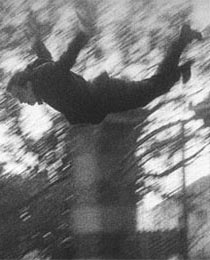
The somewhat tongue-in-cheek "First Manifesto of Nouveau Realism" included statements like, “If one succeeds at reintegrating oneself with the real, one achieves transcendence, which is emotion, sentiment, and finally, poetry.” Striving passionately to put the “re” back in realism, artists like Yves Klein, Jean Tinguely and Niki de Saint Phalle suggested that by integrating real objects and other discarded and perhaps useless materials into artistic objects, and thus altering their intended purpose, an increasingly industrial and consumer-based culture could be momentarily altered.
Using the tools of industry and violence, the Nouveau Realistes constructed intricate, performance-driven works like Klein’s "Sunday, the Newspaper of a Single Day," which offered shamelessly self-promoting stories about avant-garde artists, specifically Klein as well as his photo-series "The Leap into the Void," in which the showman-artist was captured supposedly in mid-air hurling himself off a Parisian rooftop. That series is the heart of this delightful exhibit, from which its title, "Leaps into the Void" derives. It effectively captures the desperate, passionate and yes, hilariously delusional essence of the creative impulse.
“The Leap” was such an inspiration to Dominique de Menil that she traveled to Paris to harvest tiles from the very roof Klein leapt off. The souvenirs are included in the exhibit, and it lends a rock-star element to these artists and their reputations. It’s a similar feeling to the street-art sensations of today. Mimmo Rotella’s “Senza Titolo (Untitled)” is a perfect example of the decollage technique beloved by the Nouveau Realists. The artist utilized torn movie posters to create abstract compositions that transform advertising into illegible, scarred surfaces — a direct ancestor of present-day street art.
A series of works by the husband/wife team Jean Tinguely and Niki de Saint Phalle dominate one room. Tinguely was a founding member of the Nouveau Realist movement; de Saint Phalle was one of the last invited to join. Their collaborations, kinetic, mechanized sculptures made from junkyard scraps, fused humor with a dreadful foreboding of doom. The largest on display, “M.O.N.S.T.R.E.,” resembles a skeletal, flayed-apart dinosaur or a scorched, wingless bird. The sculptures’ mechanisms are timed to activate on the hour.
Don’t miss the films. Francois de Menil’s 1966 film “Hon-en Katedral” captures the building (and deconstruction) of Tinguely and de Saint Phalle’s massive sculpture of the same name. The colorful “Nana,” referring to one of de Saint Phalle’s stylistic periods in which she constructed archetypal female figures, is a giant shell in the shape of a woman lying on her back with legs open. Visitors line up to enter the sculpture, which contains several of Tinguely’s mechanized sculptures, through the vagina. Then the entire work is destroyed using circular saws that send fountains of sparks flying.
Another film, by Peter Schamoni, documents de Saint Phalle creating one of her famous “shooting paintings.” De Saint Phalle narrates, asserting herself firmly into the art world as a friend of Robert Rauschenberg and Jasper Johns, describing herself as a scorpionic art-terrorist. We can see her slightly grin as she aims her rifle at a huge canvas loaded with paint pouches and spray-paint cans that splatter and explode when the bullets impact. And the paintings are beautiful, visceral images, despite the histrionic way they were made. De Saint Phalle exclaims, “The painting is crying. The painting is dying. I’ve killed the painting!” Rather, it’s a rebirth. The lie becomes the truth (With a wink and a smirk).
